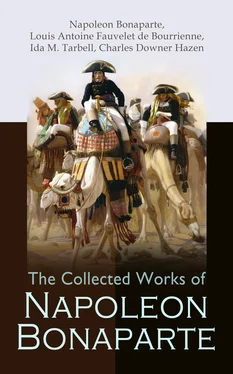On April 24th is issued from Ratisbon his proclamation to the army:—"Soldiers, you have justified my expectations. You have made up for your number by your bravery. You have gloriously marked the difference between the soldiers of Cæsar and the armed cohorts of Xerxes. In a few days we have triumphed in the pitched battles of Thann, Abensberg, and Eckmühl, and in the combats of Peising, Landshut, and Ratisbon. A hundred cannon, forty flags, fifty thousand prisoners.... Before a month we shall be at Vienna." It was within three weeks! He was specially proud of Eckmühl, and we are probably indebted to a remark of Pasquier for his chief but never divulged reason. "A noteworthy fact in connection with this battle was that the triumphant army was composed principally of Bavarians and Wurtembergers. Under his direction, these allies were as greatly to be feared as the French themselves." At St. Helena was written: "The battle of Abensberg, the manœuvres of Landshut, and the battle of Eckmühl were the most brilliant and the most skilful manœuvres of Napoleon." Eckmühl ended with a fine exhibition of a "white arm" mêlée by moonlight, in which the French proved the superiority of their double cuirasses over the breastplates of the Austrians. Pelet gives this useful abstract of the Campaign of Five Days:—
April 19th. —Union of the French army whilst fighting the Archduke, whose base is already menaced.
April 20th. —Napoleon, at Abensberg and on the banks of the Laber, breaks the Austrian line, totally separating the centre from the left, which he causes to be turned by Massena.
April 21st. —He destroys their left wing at Landshut, and captures the magazines, artillery, and train, as well as the communications of the enemy's grand army, fixing definitely his own line of operations, which he already directs on Vienna.
April 22nd. —He descends the Laber to Eckmühl, gives the last blow to the Archduke's army, of which the remnant takes refuge in Ratisbon.
April 23rd. —He takes that strong place, and forces the Archduke to take refuge in the mountains of Bohemia.
No. 2.
May 6th. —On May 1st Napoleon was still at Braunau, waiting for news from Davoust. Travelling by night at his usual speed he reached Lambach at noon on May 2nd, and Wels on the 3rd. The next morning he heard Massena's cannon at Ebersberg, but reaches the field at the fall of night—too late to save the heavy cost of Massena's frontal attack. The French lost at least 1500 killed and wounded; the Austrians (under Hiller) the same number killed and 7000 prisoners. Pelet defends Massena, and quotes the bulletin of May 4th (omitted from the Correspondence ): "It is one of the finest feats of arms of which history can preserve the memory! The traveller will stop and say, 'It is here, it is here, in these superb positions, that an army of 35,000 Austrians was routed by two French divisions'" (Pelet, ii. 225). Lejeune, and most writers, blame Massena, referring to the Emperor's letter of May 1st in Pelet's Appendix (vol. ii.), but not in the Correspondence .
Between April 17th and May 6th there is no letter to Josephine preserved, but plenty to Eugène, and all severe—not so much for incapacity as for not keeping the Emperor advised of what was really happening. On May 6th he had received no news for over a week.
The ball that touched me — i.e. at Ratisbon. This was the second time Napoleon had been wounded in battle—the first time by an English bayonet at Toulon. On the present occasion (April 23rd) Méneval seems to be the best authority: "Napoleon was seated on a spot from which he could see the attack on the town of Ratisbon. He was beating the ground with his riding-whip, 74when a bullet, supposed to have been fired from a Tyrolean carbine, struck him on the big toe (Marbot says 'right ankle,' which is correct). The news of his wound spread rapidly 75from file to file, and he was forced to mount on horseback to show himself to his troops. Although his boot had not been cut the contusion was a very painful one," and in the first house he went to for a moment's rest, he fainted. The next day, however, he saw the wounded and reviewed his troops as usual, and Lejeune has preserved a highly characteristic story, somewhat similar to an experience of the Great Frederick's: "When he had reached the seventh or eighth sergeant the Emperor noticed a handsome young fellow with fine but stern-looking eyes and of resolute and martial bearing, who made his musket ring again as he presented arms. 'How many wounds?' inquired the Emperor. 'Thirty,' replied the sergeant. 'I am not asking you your age,' said the Emperor graciously; 'I am asking how many wounds you have received.' Raising his voice, the sergeant again replied with the one word, 'Thirty.' Annoyed at this reply, the Emperor turned to the colonel and said, 'The man does not understand; he thinks I am asking about his age.' 'He understands well enough, sire,' was the reply; 'he has been wounded thirty times.' 'What!' exclaimed the Emperor, 'you have been wounded so often and have not got the cross!' The sergeant looked down at his chest, and seeing that the strap of his cartridge-pouch hid his decoration, he raised it so as to show the cross. He said to the Emperor, with great earnestness, 'Yes, I've got one; but I've merited a dozen!' The Emperor, who was always pleased to meet spirited fellows such as this, pronounced the sacramental words, 'I make you an officer!' 'That's right, Emperor,' said the new sub-lieutenant as he proudly drew himself up; 'you couldn't have done better!'"
No. 3.
Almost an exact duplicate of this letter goes on to Paris to Cambacérès, as also of No. 4. The moment the Emperor had heard that the Archduke had left Budweiss and was going by the circuitous route viâ Krems to Vienna, he left Enns (May 7th) and reached Moelk the same evening. Seeing a camp of the enemy on the other side of the river he sends Marbot with a sergeant and six picked men to kidnap a few Austrians during the night. The foray is successful, and three are brought before Napoleon, one weeping bitterly. The Emperor asked the reason, and found it was because he had charge of his master's girdle, and would be thought to have robbed him. The Emperor had him set free and ferried across the river, saying, "We must honour and aid virtue wherever it shows itself." The next day he started for Saint-Polten (already evacuated by Hiller). On his way he saw the ruins of Dirnstein Castle, where Richard Cœur de Lion had been imprisoned. The Emperor's comments were interesting, but are now hackneyed, and are in most histories and memoirs—the parent source being Pelet (vol. ii. 246).
No. 4.
Schoenbrunn , situated a mile from Vienna, across the little river of that name. Constant thus describes it: "Built in 1754 by the Empress Marie Thérèse, Schoenbrunn had an admirable position; its architecture, if defective and irregular, was yet of a majestic, imposing type. To reach it one has to cross the bridge across the little river Vienna. Four stone sphinxes ornament this bridge, which is very large and well built. Facing the bridge there is a handsome gate opening on to a large courtyard, spacious enough for seven or eight thousand men to manœuvre in. The courtyard is in the form of a quadrangle surrounded by covered galleries and ornamented with two large basins, in which are marble statues. On both sides of the gateway are two huge obelisks of pink stone surmounted by gilt eagles.
"In German, Schoenbrunn means 'fair spring,' and the name is derived from a fresh and sparkling spring which is situated in the park. It wells forth from a little mound on which a tiny grotto has been built, carved within so as to resemble stalactites. Inside the grotto is a recumbent naiad holding a horn, from which the water falls down into a marble basin. In summer this little nook is deliciously cool.
Читать дальше












